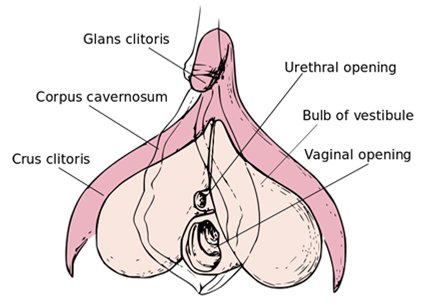"In a New View of a Woman's Body, the Feminist Center for Health identified eighteen parts in the clitoral network, many of which are unseen but are nonetheless felt or contribute to the experience of feeling."
There's More to It
Many of my early experiences with sex involved a deep expectation of two things: that penetrative intercourse was essential to shared pleasure and that I expected to be pleasured. I had no knowledge of my own anatomy and as a result, I encountered disappointment frequently. One casual encounter ended abruptly, as he told me that I was just “too difficult” to bring to orgasm. I felt like I was a game that was abandoned for lack of interest.
If only I could have taken control of my own sexual response. I didn’t realize that I was responsible for my own pleasure and I didn’t even know where all my parts were. My experience of sexual education was scant, nearly laughable: Xeroxed copies of cross-sectioned male and female anatomies were handed out in seventh grade, without labels. Our assignment was to simply color the pictures. As a result, I didn't know the specific names or functions of my anatomy or male anatomy. By the end of puberty, I had mostly figured out male anatomy, but my own was still a mystery. During one of my first sexual experiences, my high school boyfriend, exasperated by my directions, asked me to locate my clitoris. With my inadequate knowledge, and a clitoris that was often too sensitive for direct stimulation, I mistakenly pointed to my frenulum, which is located between the clitoris and the urethra. The frenulum also corresponds to the sensitive underside of the head of the penis, a site at which many men enjoy stimulation. Of course, I had no idea! In reality, genital intercourse results in the clitoris and the penis pass each other like strangers in the night.
Until I read She Comes First by Ian Kerner, I was unaware that clitorises, like trees, have deep roots; that the G-spot is really clitoral nerves intertwined with spongy urethral tissue; that women have scattered tissues that correspond to the male prostate and contribute to squirting. Despite being called a ‘little penis’ in reality, all fetuses technically develop first as females. Genitalia are present in fetuses as early as six weeks but it’s only until testosterone is produced at eleven weeks that the fetus begins to differentiate as a male. I didn’t learn these things until college, and only in a purely scientific sense.
Despite the fact that we technically all started as women and that the clitoris proves to be such an elusive yet key component to female pleasure, its discovery is often a difficult and obstructed journey for so many women. I am one of them. Being at peace with one’s sexuality and being satisfied is a fundamental right. The first step is education.
Want to know the 18 parts of the clitoris? Taken from She Comes First:
1. The front commissure
2. The glans
3. The labia majora
4. The clitoral hood
5. The frenulum
6. The fourchette
7. The hymen (or remnants of)
8. The clitoral shaft
9. The crura or clitoral cuff (leg shaped extensions of nerves)
10. The bulbs
11. The G-spot
12. The para-urethral glands
13. The vulvovaginal glands
14. The perineal sponge
15. The pelvic floor muscles
16. The suspensory ligament
17. The pudendal nerve
18. The blood vessels that supply the erectile tissue of the clitoris

Image courtesy of Wikimedia
Now you know a little more about your or your partner’s pleasure center. But just having a long list of anatomical parts isn’t exactly an education; use this list as a starting point to learn more about yourself or your partner. Lead yourself out of the sexual dark and become fluent in your sexuality; the only result is more knowledge and greater potential for satisfaction.